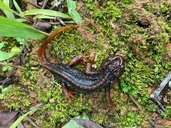|
Tylototriton umphangensis Pomchote, Peerachidacho, Hernandez, Sapewisut, Khonsue, Thammachoti & Nishikawa, 2021
Umphang Crocodile Newt, Thai: Ka Tang Nam Umphang | family: Salamandridae subfamily: Pleurodelinae genus: Tylototriton |
| Species Description: Pomchote P, Peerachidacho P, Hernandez A, Sapewisut P, Khonsue W, Thammachoti P, Nishikawa K. 2021. A new species of the genus Tylototriton (Urodela, Salamandridae) from western Thailand. ZooKeys 1072: 83-105. | |
 © 2022 Porrawee Pomchote (1 of 2) |
|
|
|
Description DIAGNOSIS Tylototriton umphangensis is most morphologically similar to T. uynoi, but the two species can be differentiated by very subtle characters. Tylototriton umphangensis is larger in size and has darker coloration in both life and preservative. Additionally, in T. umphangensis, the snout is more truncated and does not extend much beyond the jaw (vs. rounded to blunt and distinctly projected); the dorsolateral ridges are rougher, steeper, and curved; the vertebral ridge is more distinctly segmented; and the rib nodules are indistinct and small (vs. isolated, rounded, distinct, but small). From other species in the subgenus Tylototriton, the orange-brown markings of T. umphangensis differentiate it from T. taliangesis, and specifically its orange-brown parotoids separate it from T. yangi and its orange-brown public region separate it from T. kachinorum, T. pulcherrimus, and T. shanjing. Tylototriton umphangensis’ truncated snout differentiates it from T. ngarsuensis. The presence of a sagittal ridge on the head in T. umphangensis differentiate it from T. anguliceps, T. podichthys and T. phukhaensis, while the presence of steep, bony dorsolateral ridges on the head of T. umphangensis differentiate it from T. anguliceps, T. shanorum and T. verrucosus. Separated rib nodules differentiates T. umphangensis from T. kweichowensis and T. pseudoverrucosus. A narrow vertebral ridge in T. umphangensis differentiates it from T. panwaensis. Lastly, the absence of basal tail grooves in T. umphangensis differentiate it from T. himalayanus (Pomchote et. al 2021). COLORATION: In life, the body and limbs have background colors that range from dark brown to blackish-brown, with its ventral coloration slightly lighter than its dorsal coloration. Its head, vertebral ridge, limbs, vent, and tail have orange coloring, with the tip of the tail being lighter than the rest of the dorsals side of the tail. The ventral edge of its tail is lightest, connecting to the lighter coloration in the vent area. In preservative, the species’ coloring is similar (Pomchote et. al 2021). VARIATION The species’ dorsolateral bony ridges can vary in texture. Its sagittal ridge can vary in prominence and size. Its color does not vary much, but some specimens may be lighter. Its digits can vary from dark brown to black (Pomchote et. al 2021). Distribution and Habitat Country distribution from AmphibiaWeb's database: Thailand
Life History, Abundance, Activity, and Special Behaviors Trends and Threats Relation to Humans Comments PHYLOGENETIC RELATIONSHIPS Bayesian Inference of partial ND2 found that T. umphangensis is sister to T. uyenoi. The next most closely related clade is composed of T. anguliceps and T. phukhaensis (Pomchote et. al 2021). ETYMOLOGY The specific epithet, “umphangensis,” is a reference where the species is found, in the Umphang Wildlife Sanctuary (Pomchote et. al 2021).
References
Pomchote, P., Peerachidacho, P., Hernandez, A., Sapewisut, P., Khonsue, W., Thammachoti, P., Nishikawa, K. (2021). “A new species of the genus Tylototriton (Urodela, Salamandridae) from western Thailand.” ZooKeys 1072, 83-105 [link] Originally submitted by: Lily Raper (2022-12-08) Description by: Lily Raper (updated 2022-12-08)
Distribution by: Lily Raper (updated 2022-12-08)
Life history by: Lily Raper (updated 2022-12-08)
Trends and threats by: Lily Raper (updated 2022-12-08)
Relation to humans by: Lily Raper (updated 2022-12-08)
Edited by: Ann T. Chang (2022-12-08) Species Account Citation: AmphibiaWeb 2022 Tylototriton umphangensis: Umphang Crocodile Newt <https://amphibiaweb.org/species/9474> University of California, Berkeley, CA, USA. Accessed Apr 25, 2024.
Feedback or comments about this page.
Citation: AmphibiaWeb. 2024. <https://amphibiaweb.org> University of California, Berkeley, CA, USA. Accessed 25 Apr 2024. AmphibiaWeb's policy on data use. |


 Map of Life
Map of Life